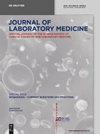Assessment of antibody titer after third doses of COVID-19 mRNA vaccination in healthy volunteers
IF 1.8
4区 医学
Q4 MEDICAL LABORATORY TECHNOLOGY
引用次数: 3
Abstract
As of the end of January 2022, severe acute respiratory syndrome coronavirus-2 (SARS-CoV-2) has infected over 351 million individuals worldwide and caused more than 5.6 million deaths. In the year of 2021, numerous groups, including us, have been reported about humoral responses and side effects after two doses of BNT162b2 vaccinations [1–4]. Subsequently, third dose of SARS-CoV-2 vaccination have just started from December 1, 2021 in Japan. Currently, several groups have started to report humoral responses after third doses of vaccinations, indicating an efficacy of a third dose [5–7]. However, further studies are warranted to verify these findings. Our group have recently reported antibody titers and side effects after two doses of BNT162b2 vaccination [4], and subsequent study of antibody decline 6 months after first vaccination [8]. In the current study, we examined levels of SARS-CoV-2 antibodies among healthy volunteers at Tohoku Medical and Pharmaceutical University Hospital, before and after vaccination with the Pfizer/BioNTechBNT162b2mRNAvaccine for the third time. Antibody titers were evaluated using a newly established, highly sensitive, fully automated chemiluminescent enzyme immunoassay (CLEIA) designed to specifically detect IgG and IgM against the SARS-CoV-2 spike protein receptor-binding domain (RBD) as described [4, 8]. Of 41 volunteers who received two doses of BNT162b2 at our hospital, all completed 9 months of follow-up after the first dose. At the time of writing, all 41 participants have completed this period, and none experienced SARS-CoV-2 infections prior to third vaccination or during post-third vaccination follow-up. Serum samples were obtained on average 279.5 days (SD 5.5 days) after the first dose of BNT162b2 (Figure 1A). 264.4 days (SD 5.8 days) after the first dose of BNT162b2, mean anti-RBD IgM was 0.3 C.O.I. (SD 0.3), which was baseline level and equal to day 0 and 180 days after first vaccination [4] (Figure 1B). Additionally, mean anti-RBD IgG antibodies was 17.3 AU/mL (SD 13.1) at 264.4 days after vaccination (Figure 1C),whichwas 6.36%of the antibody after the second dose. At 15 days after the third vaccination (day 279.5), anti-SARS-CoV-2 IgM was modestly but significantly increased (average, 1.7 C.O.I. [SD 3.9], 5.7-fold increase) (Figure 1B), while anti-SARS-CoV-2 IgG was more markedly increased (average, 702.9 AU/mL [SD 402.9], 40.6-fold increase) (Figure 1C). Quite recently, the antibody titers before and after a third dose of the SARS-Cov-2 BNT162b2 vaccine in adults agedmore that 60 years (n=97) have been published [7]. In their study, median IgG titer was increased from 440 to 25,468 (AU/mL), with no major adverse events. From the retrospective cohort study, Saciuk et al. [9], concluded that the third dose provides added protection against SARS-CoV-2 infection for those vaccinated 6 months ago. Barda et al. [10], recently demonstrated that using data from mandatory health-care coverage for over half of the Israeli population, and compared 0.728 million individuals receiving a third vaccine dose to demographically and clinically similar controls who did not receive a third dose. As a result, admission to hospital (231 vs. 29), severe disease (157 vs. 17) and death (44 vs. 7) is significantly reduced in the population vaccinated with three doses [10]. The long-term efficacy of BNT162b2 vaccination remains to be determined. Our current study may have limitations, such as small sample size, lack of cellular immunity testing and neutralizing antibody testing. However, based on our observations of dramatic increase of IgG *Corresponding author: Shinichiro Takahashi, Division of Laboratory Medicine, Tohoku Medical and Pharmaceutical University, 1-15-1, Fukumuro, Miyagino-ku, Sendai, 983-8536, Japan, Phone: +81 22 290 8889, E-mail: shintakahashi@tohoku-mpu.ac.jp Rikei Kozakai, Kuniko Hoshi and Yoshihiko Izumi, Department of Clinical Laboratory, Tohoku Medical and Pharmaceutical University Hospital, Sendai, Japan J Lab Med 2022; 46(2): 151–153健康志愿者第三次接种COVID-19 mRNA疫苗后抗体滴度的评估
截至2022年1月底,严重急性呼吸综合征冠状病毒-2 (SARS-CoV-2)已在全球感染了3.51亿多人,造成560多万人死亡。在2021年,包括我们在内的许多研究小组都报道了两次接种BNT162b2疫苗后的体液反应和副作用[1-4]。随后,日本从2021年12月1日开始进行第三剂新冠肺炎疫苗接种。目前,一些研究小组已经开始报告第三次接种疫苗后的体液反应,表明第三次接种疫苗的有效性[5-7]。然而,需要进一步的研究来证实这些发现。我们小组最近报道了两剂BNT162b2疫苗[8]后的抗体滴度和副作用,以及首次接种[8]后6个月抗体下降的后续研究。在目前的研究中,我们第三次检测了东北医药大学医院健康志愿者接种辉瑞/ biontechbnt162b2mrnavvaccine前后的SARS-CoV-2抗体水平。抗体滴度采用新建立的高灵敏度全自动化学发光酶免疫分析法(CLEIA)进行评估,该方法专门用于检测针对SARS-CoV-2刺突蛋白受体结合域(RBD)的IgG和IgM[4,8]。41名志愿者在我院接受了两剂BNT162b2,在第一次剂量后全部完成了9个月的随访。在撰写本文时,所有41名参与者都完成了这一时期,并且在第三次疫苗接种之前或第三次疫苗接种后随访期间没有出现SARS-CoV-2感染。首次给药BNT162b2后平均279.5天(SD 5.5天)采集血清样本(图1A)。首次接种BNT162b2后264.4天(SD 5.8天),平均抗rbd IgM为0.3 C.O.I. (SD 0.3),与首次接种[4]后第0天和180天的水平相同(图1B)。此外,在接种后264.4天,平均抗rbd IgG抗体为17.3 AU/mL (SD 13.1)(图1C),为第二次接种后抗体的6.36%。在第三次疫苗接种后15天(第279.5天),抗sars - cov -2 IgM轻微但显著增加(平均1.7 C.O.I. [SD 3.9],增加5.7倍)(图1B),而抗sars - cov -2 IgG更显著增加(平均702.9 AU/mL [SD 402.9],增加40.6倍)(图1C)。最近,在60岁以上的成年人(n=97)中,第三剂SARS-Cov-2 BNT162b2疫苗接种前后的抗体滴度已被公布。在他们的研究中,IgG滴度中位数从440增加到25,468 (AU/mL),无重大不良事件发生。Saciuk等人从回顾性队列研究中得出结论,第三剂疫苗为6个月前接种疫苗的人提供了额外的预防SARS-CoV-2感染的保护。Barda等人最近利用以色列一半以上人口的强制性医疗保健覆盖数据,将接受第三剂疫苗的72.8万人与未接受第三剂疫苗的人口统计学和临床相似的对照组进行了比较。因此,在接种三剂bbb的人群中,入院率(231比29)、严重疾病(157比17)和死亡率(44比7)显著降低。BNT162b2疫苗的长期疗效仍有待确定。我们目前的研究可能有局限性,如样本量小,缺乏细胞免疫测试和中和抗体测试。通讯作者:Shinichiro Takahashi,东北医药大学检验医学部,1-15-1,仙台市宫野区福村,983-8536,日本,电话:+81 22 290 8889,E-mail: shintakahashi@tohoku-mpu.ac.jp,日本仙台市东北医药大学医院临床检验科,Kozakai Rikei, Hoshi Kuniko和Izumi Yoshihiko J Lab Med 2022;46 (2): 151 - 153
本文章由计算机程序翻译,如有差异,请以英文原文为准。
求助全文
约1分钟内获得全文
求助全文
来源期刊

Journal of Laboratory Medicine
Mathematics-Discrete Mathematics and Combinatorics
CiteScore
2.50
自引率
0.00%
发文量
39
审稿时长
10 weeks
期刊介绍:
The Journal of Laboratory Medicine (JLM) is a bi-monthly published journal that reports on the latest developments in laboratory medicine. Particular focus is placed on the diagnostic aspects of the clinical laboratory, although technical, regulatory, and educational topics are equally covered. The Journal specializes in the publication of high-standard, competent and timely review articles on clinical, methodological and pathogenic aspects of modern laboratory diagnostics. These reviews are critically reviewed by expert reviewers and JLM’s Associate Editors who are specialists in the various subdisciplines of laboratory medicine. In addition, JLM publishes original research articles, case reports, point/counterpoint articles and letters to the editor, all of which are peer reviewed by at least two experts in the field.
 求助内容:
求助内容: 应助结果提醒方式:
应助结果提醒方式:


